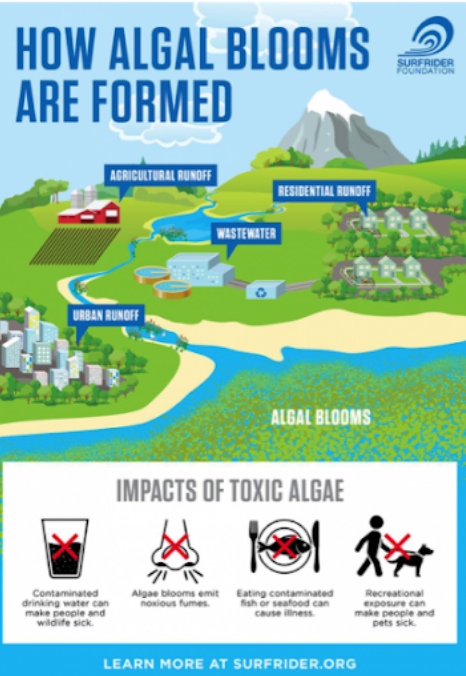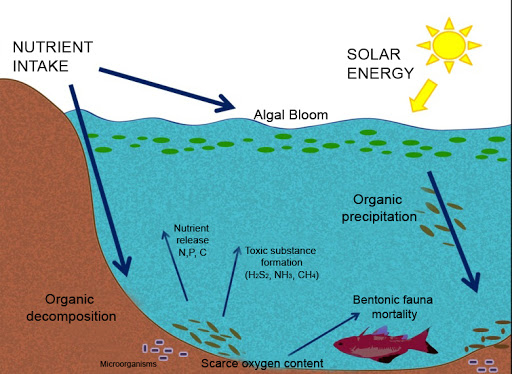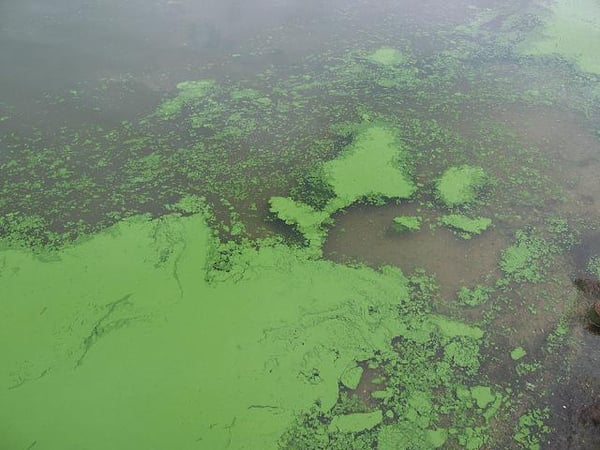Surface Water: Our essential guide to surface water and the impact of algae
Surface Water: Our essential guide to surface water and the impact of algae
Table of Contents
- How do you define surface water?
- What causes eutrophication?
- What are algae?
- What causes algae and how is it formed?
- Algal growth: timing and nutrient needs
- Impact of algae on surface water?
- How to get rid of blue-green algae in lakes?
- How to prevent algae blooms in lakes
Our essential guide to algae and surface water - looking at what it is, what causes it and how to prevent it building up in our drinking water ecosystems.
How do you define surface water?
Surface water, according to the National Geographic encyclopedic entry, is: “Any body of water above ground, including streams, rivers, lakes, wetlands, reservoirs, and creeks. The ocean, despite being salt water, is also considered surface water.”
A key part of the hydrologic cycle, precipitation and water run-off feed surface water bodies. Surface water can lose water through evaporation and seepage of water into the ground - what is known as groundwater. Although surface water and groundwater can also feed into one and the other.
There are three types of surface water:
- Perennial — Perennial, or permanent, surface water persists throughout the year and is replenished with groundwater when there is little precipitation.
- Ephemeral — Ephemeral, or semi-permanent, surface water exists for only part of the year. Ephemeral surface water includes small creeks, lagoons, and water holes.
- Man-made — Man-made surface water is found in artificial structures, such as dams and constructed wetlands.
Surface water is our most easily accessible water, far more so than groundwater. As our main source of drinking water, it also plays a vital role in the irrigation. Research conducted by the USGS in 2015 revealed that 70 per cent of all water used in the United States came from surface water.
“Research conducted by the USGS in 2015 revealed that 70 per cent of all water used in the United States came from surface water.”
What causes eutrophication?
Nature defines eutrophication as being “characterized by excessive plant and algal growth due to the increased availability of one or more limiting growth factors needed for photosynthesis, such as sunlight, carbon dioxide, and nutrient fertilizers.”
Eutrophication occurs naturally over centuries as bodies of water age and accumulate debris. Human agricultural and industrial activities have accelerated this process, releasing excess nutrients like nitrogen and phosphorus, both directly and indirectly.
In 2008, a University of Alberta survey on global lakes found that: 54% of Asian lakes, 53% in Europe, 48% in North America, 41% in South America, and 28% in Africa are affected by eutrophication.
Eutrophication is caused by three main factors:
- Fertilizers - Agricultural fertilizer use contributes to nutrient accumulation in soil. Excess nutrients, unable to be absorbed by the soil, are washed away by rain into rivers and groundwater, affecting surface water ecosystems.
- Discharge of wastewater - Around the world, and in commonly developing countries, wastewater is discharged directly into surface water bodies. This results in the release of a high quantity of nutrients, which stimulates the growth of algae.
- Reduction of self-purification capacity - Over time, lakes and rivers accumulate organic material and human debris, which absorb nutrients and pollutants, reducing the water's self-purification capacity. This accumulation increases interactions between water and debris, leading to resuspension of bottom nutrients.
Image credit: Eniscuola
What nutrients are in water?
Water is comprised of hydrogen and oxygen, and naturally calorie-free. Surface water can sometimes contain traces of minerals like calcium, magnesium, sodium, zinc, and copper.
Nutrients are an important indicator of surface water quality because inorganic nitrogen and phosphorus control the growth of aquatic plants. Excessive growth of aquatic plants can cause dissolved oxygen concentrations in streams to decrease during the night to levels that may not sustain certain species of fish.
What does cyanobacteria mean?
Cyanobacteria is a type of algae that lives in water whose microorganisms are capable of performing photosynthesis. They are commonly referred to as 'blue-green' algae.
Because they are bacteria, they are quite small and usually unicellular, though they often grow in colonies that are large enough for us to see.
The word 'cyanobacteria', according to the Collins English dictionary, means; "a group of photosynthetic bacteria (phylum Cyanobacteria) containing a blue photosynthetic pigment".
They have the distinction of being the oldest known fossils, as they are more than 3.5 billion years old.
Where are cyanobacteria found?
Cyanobacteria can be found naturally in all types of water, according to the CDC. The single-celled organisms live in fresh, brackish (combined fresh and saltwater), and marine water.
One of the most common types of algae, cyanobacteria do not require anything other than sunlight to grow, making most open surface water bodies perfect habitats for it to grow.
Image credit: EPA
What are algae?
Algae, in its simplest terms, can be defined as a group of aquatic organisms that are able to perform photosynthesis, Live Science.
Most people are aware of the most common types of algae; for example seaweed, pond scum and even algal blooms that grow in lakes. Yet, there is a lot more to know and understand about algae than what we clean out of our garden ponds.
Where are algae found?
Algae can be found in almost any freshwater or saltwater body. As most algae requires sunlight to grow, the surface makes an ideal environment for algae to bloom.
The title, “Algae”, can cover a variety of organisms that are capable of producing oxygen through sunlight - but these organisms are not that closely related.
There are, however, certain key characteristics that unite them while distinguishing them from plants found on dry land.
According to Laura Barsanti & Paolo Gualtieri, the authors of Algae: Anatomy, Biochemistry, and Biotechnology, algae are not highly differentiated in the way plants are. They lack true roots, stems and leaves, while also lacking a vascular system to distribute water and nutrients around its body.
Algae can exist as a single, microscopic cell or as macroscopic and multicellular. They can live in colonies and even take on a leafy appearance - as can be seen in seaweeds and giant kelp.
Algae thrive in diverse aquatic environments, from freshwater lakes to saltwater oceans, showing remarkable resilience to fluctuating conditions like temperature, oxygen levels, acidity, and turbidity.
“Able to grow in a wide range of aquatic habitats, algae can flourish in freshwater lakes and saltwater oceans.”
A majority of algae are autotrophs or photoautotrophs, deriving nutrients from sunlight through photosynthesis. However, there are heterotrophic algae that require organic materials like carbohydrates, proteins, and fats to grow.
Algae reproduce through asexual or vegetative methods. Asexual methods involve the production of motile spores, while vegetative reproduction occurs through simple mitosis, producing identical offspring.
There are seven major types of algae, each featuring distinct sizes, colours, and functions:
Euglenophyta (Euglenoids)
A fresh and saltwater protists (a diverse collection of organisms). Like plant cells, some euglenoids are autotrophic. They lack a cell wall but instead are covered by a protein-rich layer called the pellicle.
Chrysophyta (Golden-brown algae and Diatoms)
The most plentiful types of unicellular algae, accounting for around 100,000 different species. Both can be found in fresh and saltwater environments. Diatoms are more common than golden-brown algae and consist of many types of plankton found in the ocean.
Xanthophyta (Yellow-green algae)
Are the least prolific species of algae, with only 450 to 650 species. They are unicellular organisms with cell walls made of cellulose and silica, and usually form in small colonies of only a few cells. Yellow-green algae typically live in freshwater but can be found in saltwater and wet soil environments.
Pyrrophyta (Fire algae)
Unicellular algae, prevalent in oceans and some freshwater sources, are divided into two classes: dinoflagellates and cryptomonads. Dinoflagellates can induce red tides, turning the ocean red due to their abundant presence. They produce neurotoxins harmful to humans and other organisms, disrupting muscle function. Cryptomonads, akin to dinoflagellates, may also trigger harmful algal blooms, resulting in reddish or dark brown water.
Chlorophyta (Green algae)
Found commonly in freshwater environments, although a few species can be found in the ocean. Like fire algae, green algae also have cell walls made of cellulose, and some species have one or two flagella. Green algae contain chloroplasts and undergo photosynthesis. There are thousands of unicellular and multicellular species of these algae. Multicellular species usually group in colonies ranging in size from four cells to several thousand cells. Types of green algae include sea lettuce, horsehair algae, and dead man's fingers.
Paeophyta (Brown algae)
The largest species of algae, consisting of varieties of seaweed and kelp. These species have differentiated tissues, including an anchoring organ, air pockets for buoyancy, a stalk, photosynthetic organs, and reproductive tissues that produce spores and gametes.
Rhodophyta (Red algae)
Commonly found in tropical marine locations. Unlike other algae, these eukaryotic cells lack flagella and centrioles. Red algae grow on solid surfaces including tropical reefs or attached to other algae.
What does algal bloom mean?
Algal blooms, or HABS, refer to the uncontrolled growth of certain microalgae, which leads to the production of toxins, disruption of the ecosystems and increases the costs of water treatments, according to the Environmental Protection Agency (EPA).
Why is algae bad?
Algae isn’t necessarily bad but it can have harmful effects on its environment and the animals living in them. As an algal bloom colony grows they release toxins that can kill fish, small mammals, birds and, if ingested by humans, can cause severe illness or even death.
Other algae are non-toxic, but instead are harmful as they eat all the oxygen in water as they decay, clog fish gills and smother coral and submerged aquatic vegetation.
In freshwaters, cyanobacteria (blue-green algae) are the main toxin producers, though some eukaryotic algae also cause problems. Algae use the toxins to protect themselves from being eaten by small animals.
The phenomenon is known as eutrophication or nutrient pollution- when there is an excess amount of nitrogen and phosphorous added to the ecosystem. The fertilizers that we use in agriculture and animal manures are rich in nitrogen and improperly treated wastewater is high in both nitrogen and phosphorus, according to the EPA.
What causes algae and how is it formed
Algae and algal blooms are formed as a result of several factors including; available nutrients, temperature, light, ecosystem, disturbance, hydrology and the chemistry of the water.

It is a combination of these factors that cause algae to form:
- Nutrients - Nutrients promote and support the growth of algae and cyanobacteria. The eutrophication of waterways is considered as a major factor. The main nutrients contributing to eutrophication are phosphorus and nitrogen. Run-off and soil erosion from fertilised agricultural areas and lawns, erosion from river banks, river beds, land clearing (deforestation), and sewage effluent are the major sources of phosphorus and nitrogen entering waterways. All of these are considered as external sources. Internal origin of nutrients comes from the lake/reservoir sediments. Phosphate attaches to sediments. When the dissolved oxygen concentration is low in the water (anoxic), sediments release phosphate into the water column. This phenomenon encourages the growth of algae.
- Temperature - Early blue-green algal blooms usually develop during the spring, when the water temperature is higher and there is increased light. The growth is sustained during the warmer months of the year. Water temperatures above 25 °C are optimal for the growth of Cyanobacteria.
- Light - Blue-green algae populations are diminished when they are exposed to long periods of high light intensity, but have optimal growth when intermittently exposed to highlight intensities. These conditions are met under the water surface, where the light environment is fluctuating.
- Stable Conditions - Most blue-green algae prefer stable water conditions with low flows, long retention times, light winds and minimal turbulence; others prefer mixing conditions and turbid environments. Drought, water extraction for irrigation, human and stock consumption and the regulation of rivers by weirs and dams all contribute to decreased flows of water in our river systems.
- Turbidity - Turbidity is caused by the presence of suspended particles and organic matter in the water column. High turbidity occurs when a lot of water is running through the system. Low turbidity occurs when there is only a small amount of suspended matter present in the water column. When turbidity is low, more light can penetrate through the water column. This creates optimal conditions for algal growth. In return, growing algae create a turbid environment.
“Algae requires carbon dioxide and sunlight to grow but it also needs nutrients to grow in the form of nitrogen and phosphorus.”
Algal growth: timing and nutrient needs
How long does it take for algae to grow?
The time it takes blue-green algae varies depending on the conditions it is in. However, due to its ability to gain nutrients from sunlight, this type of algae grows quickly, creating blooms that will spread across the surface of the water.
What nutrients does algae need to grow?
Algae requires carbon dioxide and sunlight to grow, but it also needs nutrients to grow in the form of nitrogen and phosphorus being the most important ones.
These nutrients can be sources from agricultural fertiliser, waster water and pollutants entering the surface water. The combination of these key nutrients and sunlight causes the algae that is capable of photosynthesis to produce chlorophyll.
Impact of algae on surface water?
Algae can impact surface water in various ways, both positively and negatively, affecting ecosystems and drinking water quality. With thousands of algae types, each exerts a unique influence on surface water dynamics.
From oxygen-producing algae to toxin-releasing strains, the impact of algae on surface water is emerging as a pressing water concern that requires attention.
Algae can exert both beneficial and detrimental effects on surface water bodies. They, along with cyanobacteria, can cause nuisances like foam build-ups, scums, and water discolouration, as noted by the Water Encyclopedia.
When algae spread rapidly in a lake or river, it forms an algal bloom. This bloom is part of the natural ageing process of lakes and can enhance primary productivity, offering significant benefits in some cases.
Algae can have useful influences on the surface water environment - with some algae producing oxygen, food for fish, oils and other useful materials, according to Live Science.
Recurrent or severe blooms can deplete dissolved oxygen as dead algae decay. In highly eutrophic lakes, these blooms can cause anoxia, resulting in fish mortality, particularly in summer.In terms of human values, the odours and unattractive appearance of algal blooms can detract from the recreational value of reservoirs, lakes, and streams. Repeated blooms may cause property values of lakeside or riverside tracts to decline.
Toxic blooms pose the biggest threat, as not only can they affect fish and other living organisms in the surface water ecosystem, but they also pose a threat to land animals and humans.
Toxic algae and cyanobacteria blooms release biotoxins into surface water, potentially causing human illnesses like gastroenteritis and lung irritations.
Less severe cyanobacterial toxins may only cause skin irritation to swimmers in algal blooms. However, ingestion of water containing biotoxins can lead to severe illness or death in animals.
How to get rid of blue-green algae in lakes?
Successfully removing blue-green algae can be difficult but can be achieved in a number of ways.
The most common way to remove blue-green algae is to simply clean the surface layer of algae with a net. However, this is a very demanding way to rid a lake of algae.
Several products are entering the market such as filters than can help to remove large amounts of blue-green algae. One of the easier ways to remove algae is to starve the cyanobacteria - which is done by carefully controlling the nutrients entering the surface water ecosystem.
Once you are controlling the nutrients entering the surface water you can remove the large blooms of algae to ensure that the blue-green algae reduce the rate of its growth.
How to prevent algae blooms in lakes
There are several ways to prevent the build-up and growth of Algae blooms:
- 1. Introduce pond aeration and water movement through aerators or fountains.
- 2. Pick up and dispose of pet waste, a common source of excess nutrients and bacteria.
- 3. Install rain barrels throughout the community to reduce polluted run-off.
- 4. Implement landscaping strategies, like xeriscaping, that increase groundwater filtration before the water enters the pond or lake.
- 5. Incorporate native vegetation, rather than cement banking or manicured lawns, around pond and lake banks. Allow natural vegetation to grow near the water’s edge.
- 6. Remove grass clippings and leaves to prevent decomposition in or around ponds and lakes.
- 7. Use phosphorus-free fertilizers and detergents to limit nutrient-rich run-off.
- 8. Consult a qualified water-management professional who can monitor the water quality regularly and advise appropriate treatments.
Related content
We promise never to send you spam and you can unsubscribe at any time!


